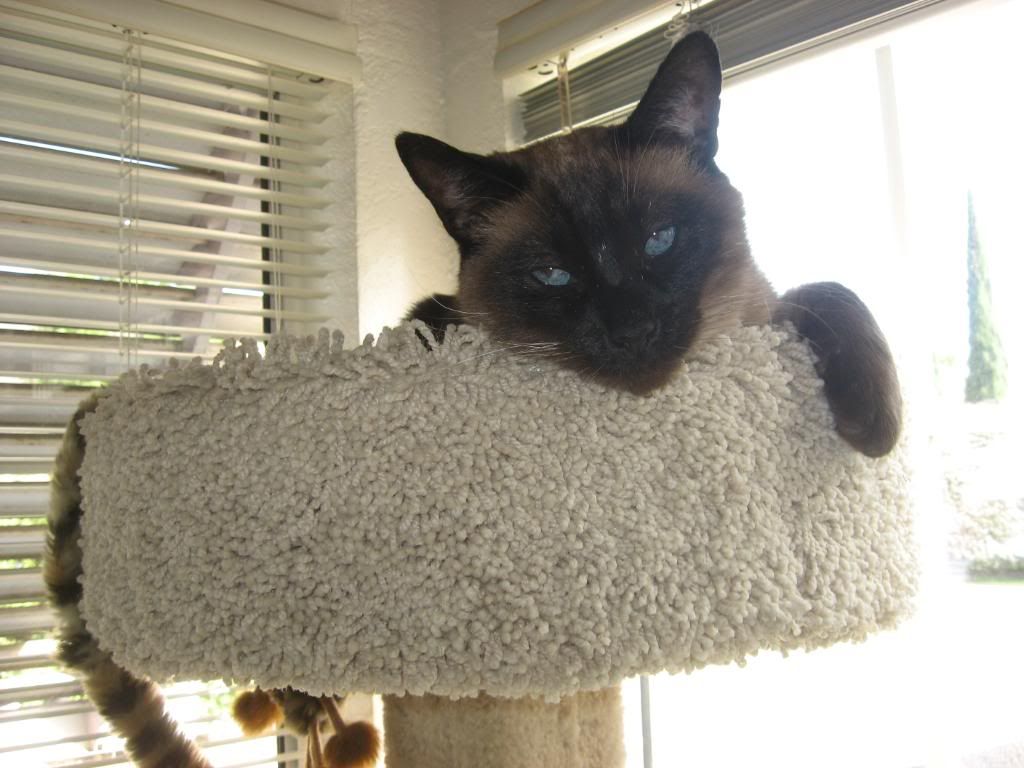
Some of you know that I have been away from the office and my home for a couple of months. I am going to be heading back and so will be busy traveling instead of blogging the next few days.
I’ll be back soon though!

Some of you know that I have been away from the office and my home for a couple of months. I am going to be heading back and so will be busy traveling instead of blogging the next few days.
I’ll be back soon though!

Above: Mr B relaxes after a training session.
So, Mr B’s cat training has been completely passed to the pet owner.
That in itself could be an entire series–but I wanted to talk about a few thoughts that have come up around his training process.
Consistent rules and behavior from the pet owner are part of compliance process but many people think that they can make exceptions to the rules.
I have one thing to say on this, “Don’t do it!”
Making exceptions to the rules established in an animal training program is a no-no.
Why?
For brevity I am not going to get into all of these points but just illustrate how a pet owner can confuse an animal.
In Mr B’s situation, he was biting and using his paws to claw in a variety of settings.
His owner has scabs on her legs from this behavior which is, for the most part, extinguished.
To get control of the issue we had to redirect Mr B into more appropriate patterns of behavior.
He now knows that if he desires food, the proper response is to go sit and wait at an appropriate location away from the food and outside of the kitchen where he is fed.
Mr B is no longer allowed:
Since he is also in a weight reduction program, he is moving over to sit at his stationing area frequently.
He is communicating that he wants food but using the redirected behavior to get that point across–which is what the goal was.
He does get reinforced with the clicker and a tidbit of food periodically to reinforce that choice–but also to teach the owner to recognize that signal.
Most pet owners only notice pet behavior when it is something undesirable.
He does still rush the pet owner because the habituated pattern in both the owner and animal has not been completely extinguished and so, as he tests the parameters with her, he sometimes gets reinforced for moving toward the food bowl or not going to his “station.”
This is not the only inconsistency happening. However, is a normal part of the learning curve of the owner who is attempting to change the dynamics and long-standing patterns of behavior.
Animals tend to adapt and change quicker than their owners.
People tend to hang on to patterns for 30-60 days.
It takes about 30 days to learn a new behavior and unlearning patterns sometimes takes a while as well.
The other inconsistency is the one related to biting and scratching.
Instead of redirecting the animal to play bite and scratch and appropriate object, the owner has used her hand.
So, who is at fault if the animal bites and scratches when that is an exception to the new training rules related to biting and scratching?
The owner, that’s who.
Also, the human’s play behavior involves the extension of her index finger–the same type of point she uses to threaten the cat when he bats or bites outside of play.
Yikes! Does that make any sense to you?
Think about it from the cat’s perspective. He IS allowed (and encouraged) to bite and scratch when he sees that index finger AND he is reprimanded for the same behaviors when he sees that index finger.
Basically, she is encouraging and reinforcing bad behavior and then does not get the connection that her behavior is the very reason the animal sometimes bites and scratches her.
The only saving grace is that the interaction occurs mainly in the cat tree and perhaps the SD for play behavior is the location.
Perhaps the cat will learn that biting and scratching can occur in that location (which becomes the SD) and not in others–but it probably is asking too much.
This type of conflicting communication and behavior occurs in lots of pet households that I visit.
When the rules are outlined, they need to be clear to everyone and there needs to be no exceptions to those rules.
When a dog is given a shoe or a sock to chew on, is it his or her fault when a generalization occurs and he or she chews on other shoes or socks?
You get the picture.
Reward the behavior you want and cease to encourage and don’t reward the behavior you don’t want.
If you get after your pet for misbehavior that is your fault and you are my student–you will be probably shot with a stream of water.
Ark Lady (Diana L Guerrero) is an animal expert with a degree in animal behavior, training & management and extensive experience with both wild & domestic animals. Ark Animals has been online since 1995. Read More…